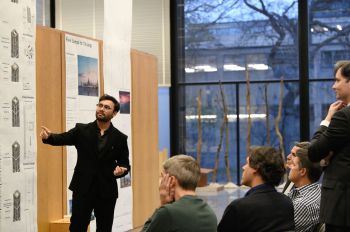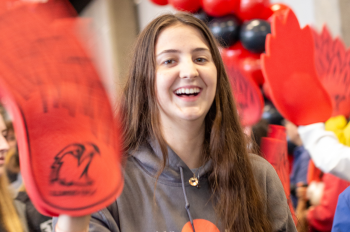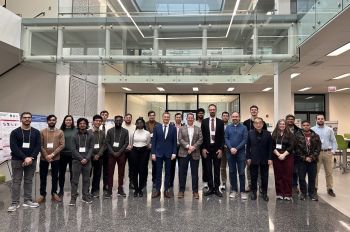Undergraduate Students Awarded Fall 2015 Armour R&D Fellowships
Eighteen Armour College of Engineering undergraduate students and their faculty mentors have been awarded Fall 2015 Armour R&D Fellowships. The program, an Armour College of Engineering Distinctive Education initiative, offers undergraduate engineering students the opportunity to gain hands-on research and development experience in the lab of a faculty mentor.
All eighteen students funded during the fall term are new to the program. Students have been selected to participate in the program based on the quality of project proposals submitted. The proposals are reviewed and selected by Natacha DePaola, Carol and Ed Kaplan Armour College Dean of Engineering, and the Distinctive Education Council.
Armour R&D will run for ten weeks, culminating with the Armour R&D Fall Expo to be held on November 19, 2015. The students will also present their work at the 2nd Armour R&D Annual Expo to be held on April 9, 2016. During these Expos, students will participate in a poster competition where they will share the results of their work and compete for awards.
The Fall 2015 Armour R&D projects are categorized under the four IIT Engineering Themes: Water, Health, Energy, and Security. These themes represent areas in which engineers can create solutions of global impact that advance society.
Health
Rachael Affenit (CHE, 3rd year) and Professor of Chemical Engineering and Director of the Engineering Center for Diabetes Research and Education, Ali Cinar, will start their project Agent Based Modeling of Osteogenesis on a Biodegradable Scaffold. Through their research, the team aims to refine the code of a high-performance bone tissue model previously created by Dr. Cinar’s research team. They will use the model to test different types of biodegradable bone tissue scaffolds in order to better understand what structures and materials best promote tissue growth. A more-precise model will allow for quick and low-cost testing of the scaffolds and help make them available to doctors more quickly.
Sean Assanuvat (CHBE, 4th year) and Assistant Professor of Chemical Engineering, Nancy Karuri, will begin work on their project The Effect of Fibronectin Concentration on the Diffusion Through Fibrin Clots. The goal of this project is to determine how fibronectin concentration influences diffusion in a fibrin matrix. This will allow the team to better understand how the diffusion of certain proteins and substances during clotting could affect the healing of a wound.
Kushal Herur (BME, 2nd year) and Assistant Professor of Biomedical Engineering, Kenneth Tichauer, will begin work on their project Mapping Tumor Heterogeneity: Studying the Significance of Variance in Optical Properties of Tissue. Dr. Tichauer’s research team has been developing a device that uses early-photon fluorescence projection tomography to construct a 3D map of a tissue sample. Herur will further the project by modeling photon transport through biological tissues to determine if photon traversal is significantly affected by variations in the tissues’ optical properties. This will help refine the accuracy of the device Dr. Tichauer’s team is developing which could lead to cancer treatments that target different characteristics within the same tumor.
Wesley Lo (BME, 2nd year) and Associate Professor of Biomedical Engineering, Georgia Papavasiliou, will begin work on their project Estimation of Pro-Angiogenic Peptide Diffusion Coefficient from Crosslinked Hydrogel Nanoparticles. The objective for this project is to estimate the diffusion coefficient of a VEGF-mimetic peptide, QK, from hydrogel nanoparticles of varying crosslink density. This will give the team a clearer picture of how these peptides diffuse through hydrogel materials used in scaffolds and help the researchers better understand the role that a sustained release of pro-angiogenic peptide sequences plays in stimulating scaffold neovascularization. Understanding how these peptides diffuse from hydrogel materials and how they affect neovascularization could lead to the development of advanced biomaterial scaffolds and the creation of new engineered tissues.
Mete Morris (EE, 2nd year) and Associate Professor of Electrical and Computer Engineering, Erdal Oruklu, will begin work on their project Policy Driven Management System for Personal Health Monitoring. The team aims to implement a policy driven management system for tele-health devices that can dynamically change how its systems operate based on changes in a patient’s condition or activity. This will allow for more accurate and energy efficient devices that monitor the health of patients and alert officials in case of an emergency.
Junxio Yu (BME, 4th year), and Professor of Biomedical Engineering and Director of the MRI Program at the Pritzker Institute, Konstantinos Arfanakis, will begin work on their project MRI Macrostructural Signatures of TDP 43 Pathology. Transactive response DNA-binding protein 43 (TDP43) pathology is recognized as a common age-related neuropathology, and is thought to occur in Alzheimer’s disease and several other neurodegenerative diseases. The objective of the research is to extract the magnetic resonance imaging (MRI) signature of TDP43 pathology in the aging brain. The team hopes this research will lead to the development of a biomarker of TDP43 pathology that will allow for the diagnosis, prevention and treatment of TDP43 and related neuropathologies in aging.
Energy
Joshua German (AE, 4th year) and Assistant Professor of Mechanical Materials and Aerospace Engineering, Carrie Hall, will begin work on their project Modeling and Dual Fuel Internal Combustion Engine. It has been shown that a single-cylinder internal combustion engine (ICE) that combusts two unique fuels can be more efficient than a regular ICE. However, these results cannot be replicated when the engine has multiple cylinders. The team will model an internal combustion engine in computer software that uses two types of fuel in order to isolate the cause of cylinder performance variation. This can lead to the development of an ICE that uses two fuel types to run cleaner and more efficiently than traditional engines.
Ruqayya Jabeen (EE, 4th year) and Assistant Professor of Electrical and Computer Engineering, Lin Cai, will begin work on their project Performance Evaluation of Wi-Fi Powered by Sustainable Energy. The objective of the team is to improve the energy efficiency of Wi-Fi networks by designing an algorithm that characterizes the performance of a networking system powered by renewable energy. They will achieve this by revising the CSMA based MAC protocol to allow energy adaptive channel sensing.
Bhaskar Babu Koyyalamudi (EE, 3rd year), Abhimanyu Pudi (CHBE, 3rd year), Rowe Family Professor of Materials Science and Engineering, Leon Shaw and Senior Research Associate, Caihong Liu, will work on their project Novel High Performance Pseudocapacitors by Deposition of Metal Oxides Inside Nanoporous Carbon. Pudi started work on this project on a volunteer basis in Dr. Shaw’s lab during the summer of 2015. He focused on finding an optimal environment for the supercapacitor electrodes that will be made as part of the current phase of research. The team’s initial findings have been submitted to an international journal for peer review. During the current phase of the project the team hopes to identify the optimal method to deposit V205 nanoparticles into active carbon (AC) nanopores in order to create a AC-V205 composite. This will be used to make supercapacitors for electronic devices that have higher capacitance and better stability than current options.
Max Romanelli (ME, 3rd year) and Assistant Professor of Mechanical Materials, and Aerospace Engineering, Carrie Hall, will begin work on their project Modeling and Control of Integrated Engine and Aftertreatment Systems. The team will work to develop an engine model using simulation software that utilizes detailed data from the engine to get a better understanding of the dynamics between the engine processes and the performance of a selective catalytic reduction (SCR) aftertreatment system. The team hopes to develop an SCR system for diesel engines that is integrated into the engine controls. This will help reduce nitrogen oxides emitted in diesel exhaust by maintaining optimal conditions in the SCR system through varying engine conditions.
Security
Padraic Chronowski (CE, 4th year) and Assistant Professor of Civil and Architectural Engineering, Mehdi Modares, will begin work on their project A Data-Drive Investigation on Reliability of Temporary Structures. The failure of temporary structures such as scaffolding, tents, and performance stages can lead to injury or death. The team seeks to make these structures safer by analyzing all available data on recent failures of temporary structures. After their review the team will identify criterion to define what constitutes a temporary structure and develop a design framework that will enhance the reliability and integrity of temporary structures.
Chee Yie Jong (CE, 3rd year) and Assistant Professor of Transportation Engineering, Lili Du, will begin work on their project Simulation Study for Optional Advance Warning Location Nearby Highway Work Zones. The team will use Paramics software to model the placement of lane merger signs in various locations in a highway work zone to establish the optimal location for the signs. Through their research the team hopes to reduce traffic congestion and dangers present in highway work zones by establishing guidelines for the placement of signs warning of lane mergers.
Water
Yusra Khalid (CHE, 3rd year) and Chair of the Department of Chemical and Biological Engineering Professor of Chemical Engineering, Sohail Murad, will begin work on their project Solar Desalination Unit with Humidification/Dehumidification Cycle Under Pakistani Climate Conditions. The research team will design the components of a solar thermal desalination system using ASPEN software and optimize those components to be used in the environment of Pakistan. This system would provide a sustainable, energy-efficient, and cost-effective solution to bring water to people in need.
Svetlana Taylor (ENVE, 2nd year) and Associate Professor of Environmental Engineering, Director of Environmental Engineering, and Co-Director of Undergraduate Initiatives and Enrichment Programs for Armour College of Engineering, Paul Anderson, will work on the project Evaluating Effectiveness of Using Weather-Sensitive First-Flush Diverter on the Quality of Roof Runoff. The team will build off prior research Taylor started in the spring of 2015 as part of the class ENGR 497: Introduction to Research Methods. In that class, Taylor and her classmate developed a first-flush diverter that prevents the initial roof run-off from entering rainwater collection systems. For the next step of the project, the team will evaluate the quality of rainwater collected using the first-flush diverter and compare it to the quality of rainwater collected without the aid of a device. They will then use EPA water safety standards to establish possible uses for the collected roof runoff and/or the extent of the additional treatment needed to make this water safe for human consumption.
Energy / Security
Hanyue Li (ECE, 4th year) Siying Liu (EE, 4th year), Rusheng Xu (ECE, 4th year) and Max McGraw Endowed Chair Professor of Energy and Power Engineering and Management, Qing-Chang Zhong, will begin work on their project High Power Density Rectifier Initiatives. The team will start by evaluating the performance of power rectifiers with neutral lag technology. They will use the results to run simulations using SIMULINK software for a power stage and controller part to optimize the rectifier circuit, the controller strategy and the calculation of system and controller parameters. The team will then focus on hardware design and testing with the goal of having a working prototype by the end of the fall session. This device will help extend the life and increase the performance of electronic devices connected to the grid that have distinct and diverse voltage requirements. The team hopes to enter the device into the 2016 IEEE International Future Energy Challenge.




